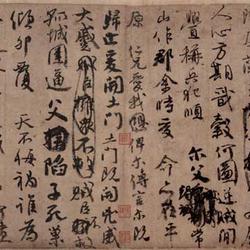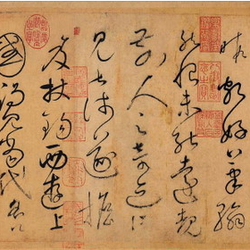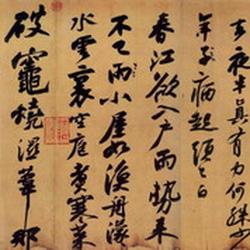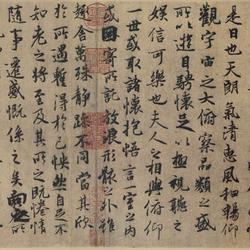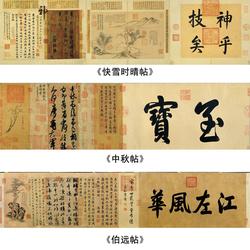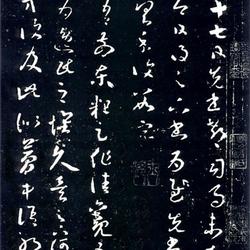Tang Dynasty - Ouyang Xun's "Zhongni Meng's Memorial Ceremony"
【Name】Zhong Ni Meng’s memorial service
[Category] Running calligraphy
【Author】Ouyang Xun
【Form】Paper
【Era】Tang Dynasty
[Original size]
[Finished product size] 25.5cm in length and 33.6cm in width (painted core)
3.5cm vertical and 341cm wide (hand rolled)
[Current Situation of Cultural Relics] Collection of Liaoning Provincial Museum
The main text of "Zhongni Meng's Memorial Ceremony"
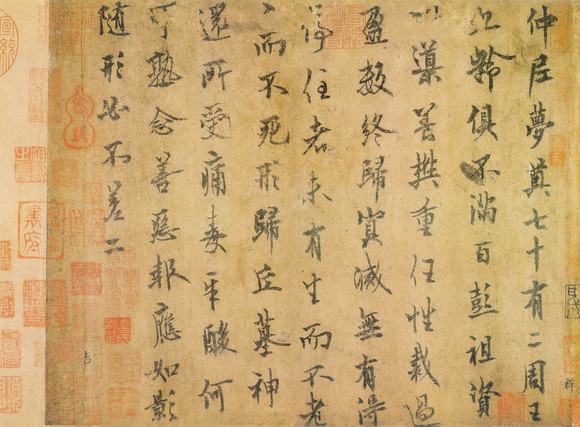
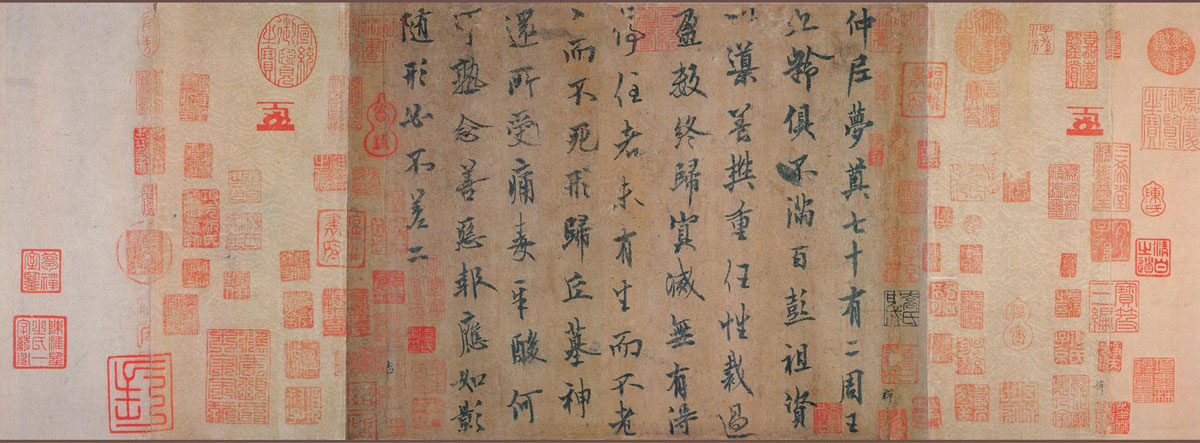
【Description of work】
"Zhongni Meng's Diantie" is written in running script, with nine lines and nine characters in each line, a total of seventy-eight characters.
Explanation: "Zhongni dreamed of laying a memorial ceremony for seventy-two. The king of Zhou was nine years old and was less than a hundred years old. Peng Zuzi guided and raised him, and Fan Zhong was responsible. He cut off the excess number and eventually perished. There is no one who can stop. There is no birth. Not old, old but not dead. The body returns to the tomb in the hill, and the gods pay back the suffering. How can we remember it so well because of the pain, poison, and bitterness. The retribution of good and evil follows each other like a shadow, and there must be no difference between the two."
This calligraphy was once collected by the Imperial Household Office of the Southern Song Dynasty, and bears two seals of the Southern Song Dynasty's "Yufu Dharma Book" in Zhu Wen. Later, it was handed over to Jia Sidao in the Southern Song Dynasty, Guo Tianxi in the Yuan Dynasty, Xiang Yuanbian in the Ming Dynasty and others, and was hidden in the inner palace of the Qing Dynasty. After the post, Zhao Mengfu and many other people wrote postscripts, and their comments basically outlined the appearance of the Fengshen in this post. The sinister writing style, careful structure, slender body, and strong writing power are the consistent styles of European books, and this post is very good in these aspects. Judging from the written words, they are all written in the language of the elderly, and the writing is clear, thin and hard. It is obviously written by Ouyang Xun in his later years.
The most striking feature of this post is that "the brush is used like a knife" - the stipples are as exquisite as knife carvings, the turns are firm and decisive, the attack is calm and powerful, the strokes have clear beginnings and ends, the threads are reflected, clean and neat, without any slack or sloppy strokes, showing that The publisher has profound pen and ink skills. Appreciating this post, we can truly feel that what the ancients said about "three points into the wood" is not an empty lie, and realize the realm of what Sun Guoting said, "people and books are old, and old is more than wonderful". To reach this state, there are not only the objective factors of advanced age, but also the reason of sublimation of skill and technique. Therefore, there is a saying that "youjun's calligraphy is better when he is late, and Yu Xin's articles are more mature when he is older". Looking at the outstanding regular script masters in history, their artistic achievements are often directly related to their age: for example, Zhong Yao was 79 years old, Ouyang Xun was 84 years old, Yan Zhenqing was 76 years old (murdered), Liu Gongquan was 87 years old, Wen Zhengming was 89 years old... where " In an era when "Zhongni dreamed of being seventy-year-old, and the king of Zhou was not even a hundred years old" and "people living seventy-year-old were rare", they were all considered "auspicious". The formation of their regular script style and the production of their masterpieces all, without exception, came from their later years (after the age of 60). This is due to the particularity of regular script - "advocating precision and precision". "Beginners learn distribution, but strive for fairness; now that they know fairness, pursue danger; now that they are dangerous, return to fairness." (Sun Guoting's "Shupu") In this long process of cultivation, I have become an old man without realizing it. It is hard to imagine that a calligrapher can complete the creation of his own style of regular script in his youth. Even if you are extremely talented and smart, it will never be possible. But this is not the case with cursive writing. At the age of 38, Mi Fu wrote such masterpieces as "Shu Su Tie" and "Tiaoxi Poetry Tie". It can be seen that regular script is obviously much slower to master than running cursive script.
However, in terms of the nature of art, there is no distinction between regular script and running cursive script. They just have different aesthetic emphasis. Cursive writing is more about expression of talent and emotion, while regular script is more about rational grasp. Therefore, regular script is recognized as the four masters of "Ou, Yan, Liu, and Zhao", while cursive script is distinguished by the writing styles of "Shen, Yi, Miao, and Neng". So when we appreciate "Meng Dian Tie", a question arises - whether the font belongs to regular script or running script? The so-called standpoint determines the point of view, and different angles will lead to different aesthetic judgments. In terms of appearance and writing style, this post undoubtedly belongs to running script, and there are even one or two cursive characters mixed in. However, whether looking at the overall composition, partial stippling, or even the details of starting, moving, and closing the brush, this work shows the characteristics of regular script with rigorous rules, solid brushwork, and full of rationality. Therefore, to be precise, this is a "dislocated creation" written in regular script. Due to the author's lofty status in the history of calligraphy, "the name is taboo" has created a misplaced aesthetic, so that many people keep it secret, or the king just talks about it. For example, Zhao Mengfu commented that "the book is pure and strong, and it is the same person in ancient and modern times." Therefore, to objectively understand this post, we must look at it from two perspectives: from the perspective of regular script, it obviously has all the aesthetic qualities of European regular script, and has been sublimated, and can be called a treasure of "Dharma script"; and from the perspective of cursive script, , is worthy of discussion. The ancients said that "the grass is noble and flowing", expressing emotion in the smoothness is the basic aesthetic quality of cursive writing. Because cursive writing focuses on the display of talent and wisdom, it has always attached great importance to the gentle and elegant atmosphere of the scroll, advocating the gentleman's demeanor of "not irritating or harsh, but staying calm and disciplined", and pays attention to the romantic charm of the virtual and the real. For thousands of years, this aesthetic ideal representing Confucianism has been the mainstream form of cursive script. In comparison, the performance of this post can be described as "Hu Yue's unique style", which is far from the best. It is needless to say that it is more rational than spiritual, and the special shape of the dense palace and steep structure makes people feel that there is an icy chill between the lines. As Guo Tianxi said: ""Meng Dian Tie" is powerful and sharp, It is as dense as a sword in an arsenal." Just imagine, how can such aesthetic taste be connected with "spirit, elegance, wonder, and energy"? Therefore, in terms of cursive writing, this post is only about one gram.
Ouyang Xun experienced three dynasties in his life: Chen, Sui and Tang. During the Sui Dynasty, he was an official, Dr. Taichang. He was already in his sixties when he entered the Tang Dynasty. Because of his excellent calligraphy, he was highly regarded by the two Tang dynasties and was granted the title of Crown Prince. It can be seen that European books were famous all over the world as early as the Sui Dynasty, but the final "European style paradigm" was born in the Tang Dynasty. But strangely, Ouyang Xun's calligraphy left no trace in the Sui Dynasty. He traveled through the Sui Dynasty during the golden period of his life (from 24 to 61 years old), and this short dynasty was a critical period for the accuracy and standardization of regular script. Ouyang Xun's absence makes no sense both emotionally and rationally. Due to the limitations of history and the serious lack of classics and materials, we can only try our best to guess. Chu Suiliang created the masterful "Preface to the Holy Religion of the Wild Goose Pagoda" at the age of 57, and Yan Zhenqing created his own "Qinli Stele" at the age of 60. Therefore, Ouyang Xun will not be blank before he is 61 years old.
【About the Author】
Ouyang Xun (557-641), courtesy name Xinben, was born in Linxiang, Tanzhou (now Changsha, Hunan). A famous calligrapher in the Tang Dynasty. His regular script is unparalleled in ancient and modern times and has a great influence on later generations. It is known as the "European style" in the world. He is the iconic figure who ushered in the heyday of regular script in the Tang Dynasty. Together with Yan Zhenqing, Liu Gongquan and Zhao Mengfu, he is known as the " Four Masters of Regular Script". There are many works handed down from generation to generation. His representative works include "Jiucheng Palace Liquan Inscription", "Huadu Temple Stele", "Yu Gonggong Stele", "Huangfu Birthday Stele", etc. His ink inscriptions include "Zhang Han Tie", "Bu Shang Tie", "Bu Shang Tie" "Zhongni Meng's Dian Tie" and so on. Among them, "Zhongni Meng's Laying Calligraphy" has no name, but it has been circulated for a long time. It is recognized as an authentic European calligraphy and is known as one of China's top ten famous calligraphy handed down from generation to generation.

